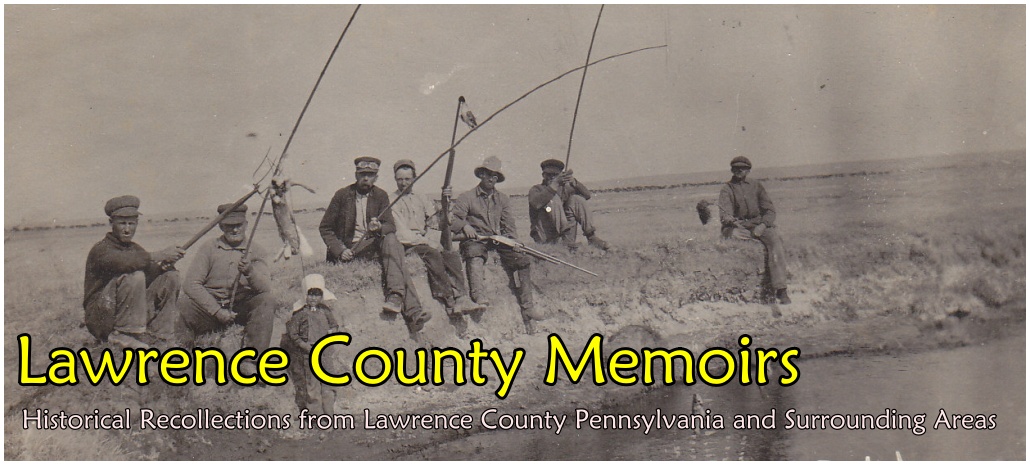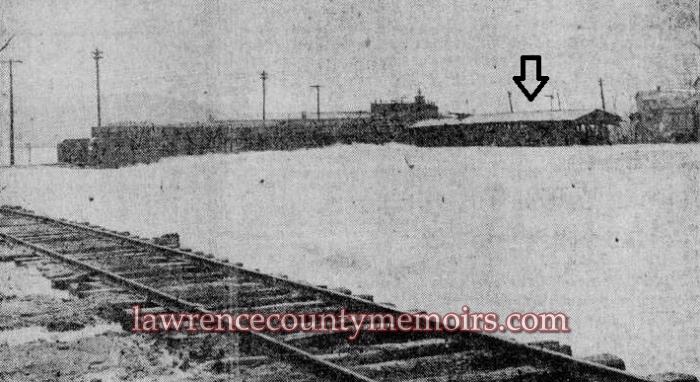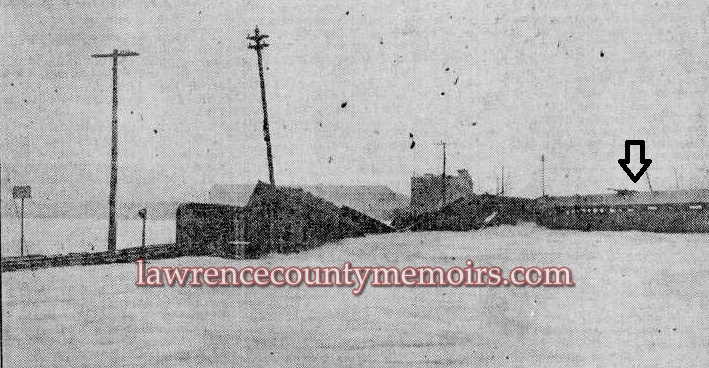In about 1851 a covered bridge, known as the Black Bridge or the Old Black Bridge, was constructed across the Shenango River in the small but growing settlement of New Castle, Pennsylvania. It stood near the confluence of the Shenango River and the Neshannock Creek, and the surrounding area was popularly known as “the Narrows.” The all-wooden span connected the downtown area with the Oakland area of Union Township – and with the Borough of Mahoningtown to the south. It was securely anchored with stone abutments on each bank of the Shenango River.
The Old Black Bridge grew in importance in the late 1800’s with the establishment of various steel, iron, and tin mill plants on both sides of the Shenango River in the immediate vicinity of the bridge. Low paid workers residing out on the West Side used the bridge to cross over to work in the mills and other factories on the South Side. Two breweries and the Etna Furnace were also located near the west end of the bridge. The span was periodically repaired and the Daily City News of Thursday, January 12, 1888, remarked, “The old Black bridge between New Castle and Union township, was built by Beaver county before Lawrence county was formed. It was never torn completely down, but the abutments of the original bridge still stand. The length of the bridge is 212 feet.”
The bridge allowed quick access to the city from the southwest, but with the coming of the railroads the situation around the bridge grew dangerous. In the 1870’s the Pennsylvania Railroad Company (PRR) laid tracks just along the west bank of the Shenango River and along a public access road leading to the Black Bridge. In the early 1880’s the Pittsburgh & Lake Erie Railroad Company (P&LE) ran tracks up along the east side of the Shenango River, which then crossed the river near the Black Bridge. The various tracks basically sandwiched the bridge and created dangerous at-grade crossings at both ends of the span. Despite periodic discussions of rectifying the dangerous situation, such as replacing the bridge with an overhead structure, the covered bridge remained in use.
Over the years the low-lying bridge was subjected to periodic floodwaters along the Shenango River, but always displayed a remarkable resiliency. This was displayed during a flood in May 1893. The New Castle News of Wednesday, May 24, 1893, remarked, “One, two, three feet high the muddy waters crept up the side; as though determined to win the victory, but no, firm as the cliff near which it was anchored, stood the bridge and laughed to scorn the very fury of the flood… “They don’t build such bridges as that now days” said Capt. J. C. Euwer to a News reporter, as he watched the defeat of the waters with evident satisfaction.” Devastating floods in October 1911 and August 1912 ravaged the downtown area and surrounding industrial areas, but the Old Black Bridge held strong.
That would change in the spring of 1913 when the city was about to face the worst natural disaster in its history. On Easter Sunday, March 23, 1913, devastating storms and tornados swept across the Midwest states. At the same time heavy rains started to inundate the states of Indiana and Ohio and the western portion of Pennsylvania. Those rains, preceded by intense storms in the previous two weeks, continued for several days and before too long a disaster was looming in New Castle.
By late Tuesday morning, as the Neshannock Creek flooded portions of the downtown area, reports started coming in about rapidly rising water along the Shenango River west of downtown. By noon a major disaster was apparent as the Shenango River angrily crested its banks. The water was six feet deep in some locations on the West Side and the tin and steel mills along the Shenango River had to stop production for a time.
The bridges on the Shenango River struggled under the immense surge of water. In the early morning hours of Wednesday, March 26, the Black Bridge broke free from its abutments and floated almost intact downriver to the amazement of onlookers. It smashed a water intake house of the Carnegie Steel Company, before continuing on and crashing against the Franklin Railroad Bridge near the Madonna Catholic Church in Oakland.
The Franklin Railroad Bridge, purposely weighted down with about eight railroad cars filled with coal, held for the time being but collapsed the following afternoon at 3:00pm. The broken up remnants of the Black Bridge floated free and soon hit the Gardner Avenue Viaduct, an antiquated structure previously slated for replacement. That bridge wilted and collapsed at 6:00pm. The Black Bridge may have floated free again and came to rest against a railroad bridge near Mahoning Ave. From there it was anchored in place that site for the time being. Further upriver, the Grant Street Bridge broke up and fell into the water in two main sections on Wednesday afternoon. Its remnants drifted downriver and came to rest against the West Washington Street Bridge, but that reinforced bridge was fortunate to survive intact.
It was another few days before most of the water had receded to allow for sufficient cleanup and repair operations to begin in New Castle, which suffered $2 million ($61 million in 2023 dollars) in damage. Meanwhile, folks began clamoring onto the remains of the still-floating Black Bridge and stripping away its planks, presumably to burn or to save as souvenirs. Police soon put a stop to it but eventually city officials had the structure broken up and cleared away.
Negotiations were underway to replace the three main bridges that were lost. Replacing the Old Black Bridge was a source of much debate, as many people favored rebuilding at a more suitable location. The railroads sought to absorb the property surrounding the former bridge and fought against the rebuilding effort. Union Township was essentially cut off from easy access to the city so officials from that township and the Carnegie Steel Company erected a temporary wooden footbridge at the site. The wooden footbridge collapsed during a heavy snow in December 1913 and was rebuilt in much studier fashion in July 1914. A similar footbridge was constructed at the site of the former Gardner Avenue Bridge.
The rebuilding debate continued in the 1920s, but the Black Bridge and the Gardner Avenue Bridge were never rebuilt. The general area was finally reopened to regular traffic when the Mahoning Avenue Viaduct was built just to the south in 1923. The Old Black Bridge, which spanned the Shenango River for many years, is remembered as one of the most iconic landmarks in the history of New Castle.
To read an article from 1893 that explains the danger the railroad tracks caused to those crossing the bridge click on: WHY DELAY ARTICLE. To read an article about the collapse of the Black Bridge in March 1913 click on: BADE ADIEU ARTICLE. To read two short articles about people tearing apart the bridge after it finally came to rest click on: TEARING BLACK BRIDGE APART ARTICLE and BLACK BRIDGE FAST DWINDLING ARTICLE. To read about the ensuing debate to replace the bridge and keep “the Narrows” route open click on: NARROWS WILL NOT BE DESERTED ARTICLE. To read about the dismantling of the Gardner Avenue Bridge click on: TAKING OLD BRIDGE OUT OF RIVER ARTICLE. To read about officials surveying the site in June 1913 in preparation of replacing the Black Bridge click on: VIEWERS AT BLACK BRIDGE ARTICLE. To read an article from May 1914 about the P&LE grabbing the property that once led to the Black Bridge on the east bank click on: P&LE GRABS ROADWAY ARTICLE. The PRR and P&LE both agitated against the rebuilding of a new bridge and sought to acquire the roads/property leading to the site. To read two articles from 1919 and 1921 that mention this land grab click on: PENNSY ASKS ELIMINATION OF NARROWS ARTICLE and ASK THAT NARROWS ROAD BE VACATED ARTICLE.
== (To read full composition by James B. Marsh click on: BRIDGE POEM)
 |









Comments
T. Clark #
The first bridge image shown cannot have been the black bridge. It is two spans long (probably about twice the length of black bridge, and had covered wooden sidewalks on each side. The river in the image is far too wide to New Castle. The church is similar to the large church in New Castle, but likely not the same church. The river isn’t this wide until down closer to Beaver Falls.
Jeff Bales Jr #
(EDITOR’S NOTE) The photo T. Clark was referring to was an image of the West Washington Street bridge, which I inadvertantly posted on this page. That bridge was located just a bit north of the Black Bridge and is now posted on the page of NEW CASTLE – West Washington Street Bridge. Jeff
Joanne Hash #
I wanted to know if there is any factual info on the old Black Bridge, such as length & was a # ever given such as McConnell’s Mill/38-37-01?
Thank you, Joanne HashI have a postcard of the image shown on this pg- w/ the Carnegie Steel Mill.
Comment